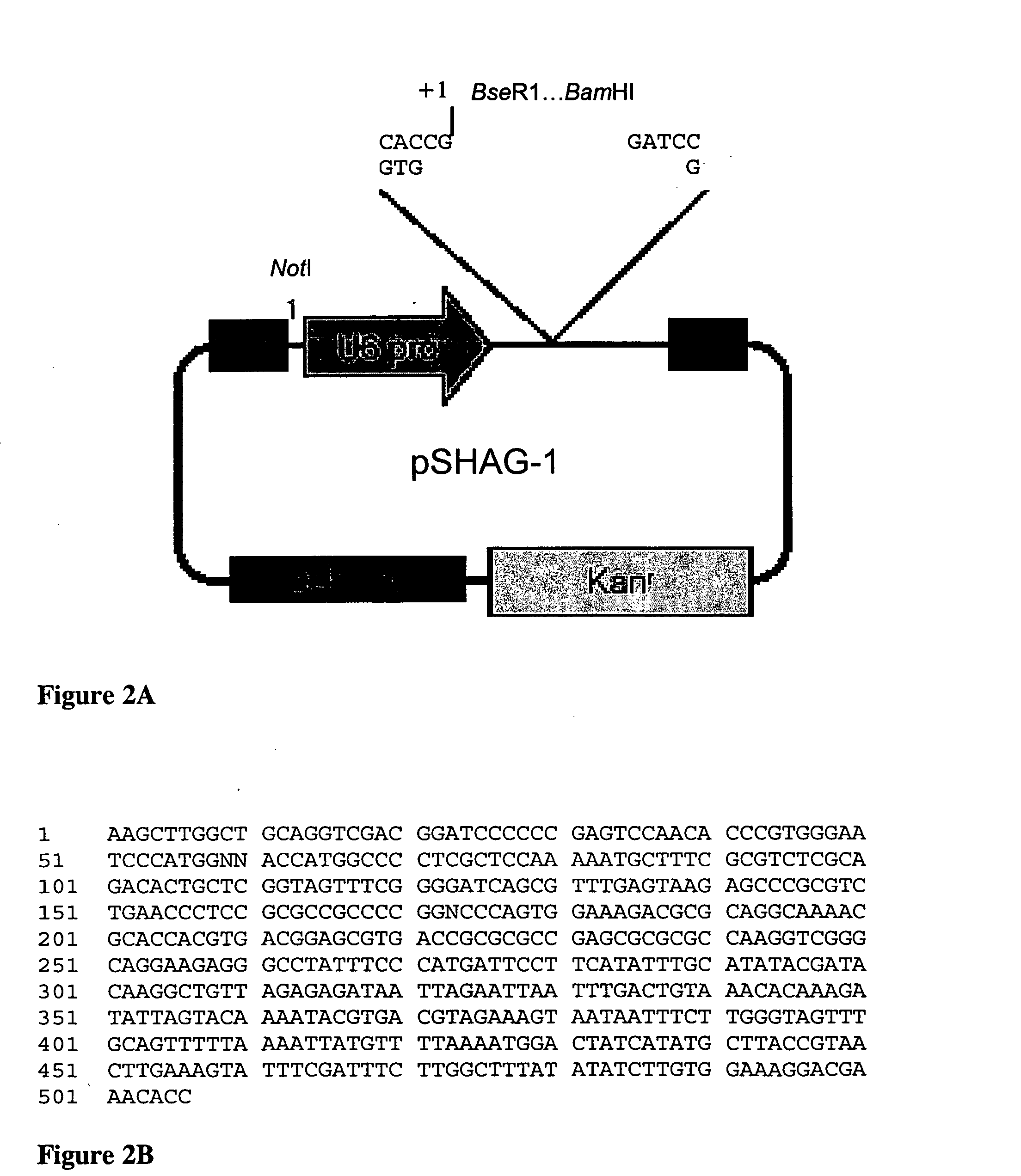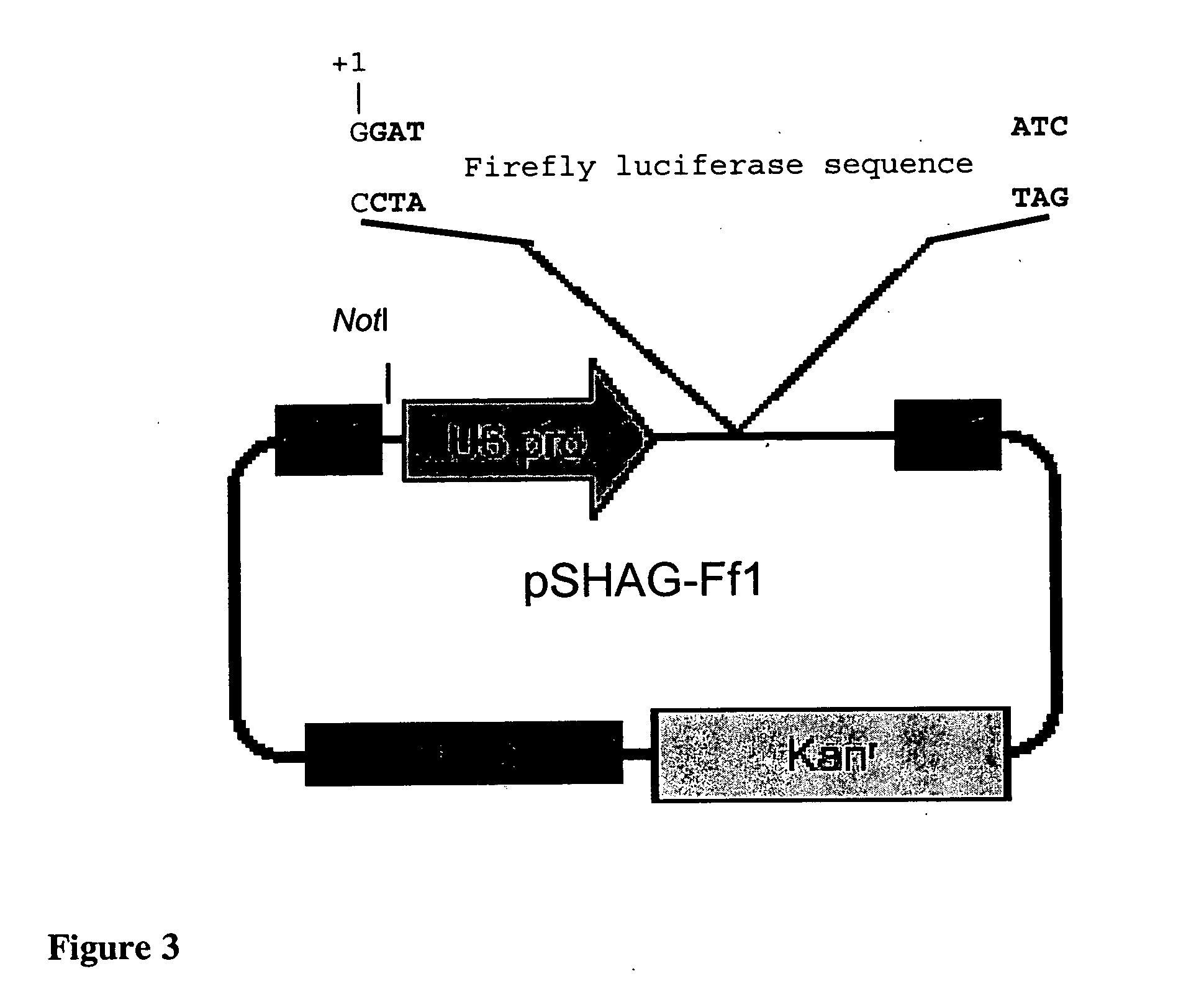In vivo high throughput selection of RNAi probes
- Summary
- Abstract
- Description
- Claims
- Application Information
AI Technical Summary
Benefits of technology
Problems solved by technology
Method used
Image
Examples
example 1
Synthesis of RNAI Candidates and Probes
[0079] Various siRNA and shRNA candidates, as well as siRNA and shRNA non-specific control probes were screened in the present invention. For the specific siRNA and shRNAs, the candidates were designated with respect to the translation initiation codon of the specific target gene, where the “A” of the start “ATG” is designated as position 1, and where the designation number indicates the most 5′ nucleotide of the target gene sequence that is specifically targeted by the siRNA. Designations are relative to mouse myoD (Genbank Accession # M84918) and human lamin A / C (Genbank Accession # NM—005572) cDNA sequences.
[0080] Chemical synthesis of siRNAs. A custom synthetic siRNA designated Lamin A / C 608 (see Table 1) was purchased from Dharmacon Research (Lafayette, Colo.). This siRNA was provided by Dharmacon as precipitated purified duplex with a purity greater than 97%. The siRNA pellet was re-dissolved in water for use in transfection
[0081] In v...
example 2
Target-Reporter Fusion Protein and Control Expression Constructs
[0097] This Example describes the assembly of various target-reporter fusion expression contructs. In all of the following examples the target-reporter fusion sequences encode a target-reporter fusion protein produced by translation of target gene and reporter sequences that were fused so as to maintain the translational frame established by a single 5′ translation intitiation sequence. For all constructs, the integrity of sequences encoding the target-reporter fusion, and the orientation of the target gene with respect to the reporter gene within these sequences, was confirmed by restriction enzyme digestion and DNA sequencing.
[0098] pDsRed2-N1, pEGFP-N2, and pRluc-N3. Plasmids pDsRed2-N1 and pEGFP-N2 (Genbank Accession # U57608) are both available from Clontech (Clontech Inc., Palo Alto, Calif.). Plasmid pRluc-N3 is available from Perkin Elmer (PerkinElmer, Boston, Mass.).
[0099] EGFP-RFP fusion construct. The red f...
example 3
Validation of the Target-Reporter Fusion Construct System
[0105] The feasibility of the experimental design was tested by evaluating critical parameters associated with the target-reporter fusion products, such as stability of fusion proteins, accessibility of target site in the chimeric mRNA, and specificity of siRNA probes in suppressing cognate gene expression as reflected by changes in reporter expression. Taken together the data indicate that the target-reporter fusion products are stable, and that the target site in the fusion mRNA is accessible for specific siRNA mediated gene suppression in both 3′end or 5′end target-reporter fusions (i.e., where the fusion sequence is organized as 5′-target-reporter-3′ or 5′-reporter-target-3′). The latter property is particularly attractive, since it allows for substantial flexibility in the construction of fusion constructs. Furthermore, these experiments showed that siRNA-mediated suppression of target gene expression is faithfully repor...
PUM
| Property | Measurement | Unit |
|---|---|---|
| Fluorescence | aaaaa | aaaaa |
Abstract
Description
Claims
Application Information
 Login to View More
Login to View More - R&D
- Intellectual Property
- Life Sciences
- Materials
- Tech Scout
- Unparalleled Data Quality
- Higher Quality Content
- 60% Fewer Hallucinations
Browse by: Latest US Patents, China's latest patents, Technical Efficacy Thesaurus, Application Domain, Technology Topic, Popular Technical Reports.
© 2025 PatSnap. All rights reserved.Legal|Privacy policy|Modern Slavery Act Transparency Statement|Sitemap|About US| Contact US: help@patsnap.com



